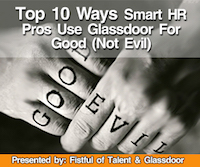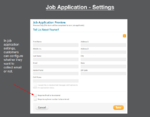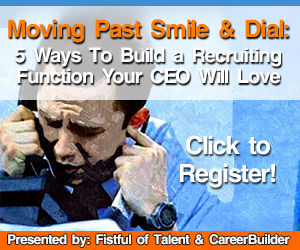WEBINAR: Top 10 Ways To Use Glassdoor For Good (Not Evil)
Some time back I wrote that I thought Glassdoor was one of the most interesting companies in the HR and HR Tech space. I believed that back then, and I think it is probably even more true today.
Ask yourself (and be honest) - If you were considering joining a new company is there any possible way you wouldn't check out their Glassdoor ratings, reviews, and interviewing tendencies?
Of course you would - you would be a fool not to. And that same logic is being applied by I bet 95% of the candidates you are trying to pluck from your competitors too. Like it or not, (and plenty of CEOs probably don't), Glassdoor and other employer reputation sources are now too big, too influential, and too much of a 'given' as a source for candidate research for you as and HR/Recruting pro to not be engaged with them on behalf of your organization.
But how to get in the Glassdoor game if you are a little late to the party? First step - close that MySpace account. And next?
Sign up for the latest installment of the FREE Fistful of Talent webinar on September 17 at 2PM EDT titled Top 10 Ways To Use Glassdoor For Good (Not Evil), where the FOT crew will hat’s why we’re going deep on reputation sites like Glassdoor.
Topics to be covered on the Webinar include:
How the the Yelp-ification of America—the trend towards consumer-based reviews in almost every area of our economy—is changing the way employees and candidates think about job search and employer brands. It’s second nature for your employees to rate a restaurant, a book or a movie online. That means that employees of all types (not just the ones who want to complain) are more willing than ever to participate in your brand through user review
The 5 Biggest Myths about company reputation sites like Glassdoor and tell you which ones are completely BS and which ones you actually perpetuate by not fully engaging on sites like Glassdoor. We’ll hit the usual suspects here: “The only comments are from the bad employees” and “The salary data out there isn’t factual,” and tell you why things have changed. More importantly, we’ll cover how you actually may make the myths a reality by not fully engaging on reputation sites. Think about that last sentence: You’ve got to be in the game to influence the game
A 10-step playbook on how to engage on reputation sites and become more of a Marketer as an HR/Recruiting Pro. It’s true—you wouldn’t have read this far if you didn’t want to learn more about how to use reputation sites like Glassdoor to maximize your company and your career. We’ll help you get started.
The FOT crew always delivers the goods, I highly recommend you get your push to the end of 2015 going strong and check out the Top 10 Ways To Use Glassdoor For Good (Not Evil), on September 17 at 2PM EDT.

 Steve
Steve


